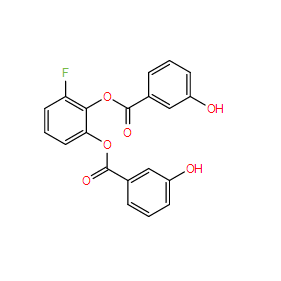| Cas No.: | 1223397-11-2 |
| Chemical Name: | 3-hydroxy-benzoic acid, (3-fluoro-1,2-phenylene)ester |
| Synonyms: | WZB117,WZB-117,WZB 117 |
| SMILES: | OC1=CC=CC(C(OC2=CC=CC(F)=C2OC(C3=CC(O)=CC=C3)=O)=O)=C1 |
| Formula: | C20H13FO6 |
| M.Wt: | 368.3 |
| Sotrage: | 2 years -20°C Powder, 2 weeks 4°C in DMSO, 6 months -80°C in DMSO |
| Description: | WZB117 is a glucose transporter 1 (Glut1) inhibitor, which downregulates glycolysis, induces cell-cycle arrest, and inhibits cancer cell growth in vitro and in vivo. |
| In Vivo: | The animal study shows that after daily intraperitoneal injection of WZB117 at 10 mg/kg body weight, the sizes of the compound-treated tumors are on average more than 70% smaller than those of the mock (PBS/DMSO)-treated tumors. Notably, 2 of the 10 compound-treated tumors disappear during the treatment and never grow back even at the end of the study. Body weight measurement and analysis reveal that the mice treated with WZB117 lost about 1 to 2 grams of body weight compared with the mock-treated mice with most of the weight loss in the fat tissue. Blood counts and analysis of mice at the end of the study show that lymphocytes and platelets are changed in the compound-treated mice compared with the vehicle-treated mice, but the cell counts remained in the normal ranges. One of the concerns for using glucose transport inhibitors is that the inhibitor might produce hyperglycemia in the treated mice[1]. |
| In Vitro: | Glucose uptake assays show that WZB117 inhibits glucose transport in cancer cells in a dose-dependent manner. The inhibition of glucose transport induced by WZB117 occurres within 1 minute after the assay started, suggesting that the inhibitory activity is likely to be via a direct and fast mechanism. Cell viability assay shows that WZB117 inhibits cancer cell proliferation with an IC50 of approximately 10 μM. The inhibitory activity of WZB117 on cancer cell growth is also confirmed with a clonogenic assay, which also indicates that the inhibition is irreversible in nature. WZB117 treatment results in significantly more cell growth inhibition in lung cancer A549 cells than in nontumorigenic lung NL20 cells. Similar results are also observed in breast cancer MCF7 cells and their nontumorigenic MCF12A cells. When WZB117 is added to cancer cells grown under hypoxic conditions, more cell growth inhibition is observed than under normoxic conditions[1]. |

 DC Chemicals' products qualify for U.S. tariff exemptions. We guarantee no price increases due to customs duties and maintain stable supply, continuing to deliver reliable research solutions to our American clients.
DC Chemicals' products qualify for U.S. tariff exemptions. We guarantee no price increases due to customs duties and maintain stable supply, continuing to deliver reliable research solutions to our American clients.





















